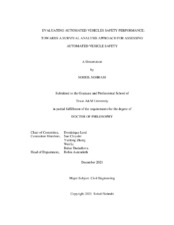| dc.description.abstract | Automated vehicle (AV) safety needs to be evaluated for successful development and deployment. However, the AV safety evaluation literature is scarce, and AV safety has not been validated yet. This study (1) synthesizes the existing knowledge about AV safety evaluations, (2) proposes a new methodology to address the gaps in AV safety evaluations, and (3) designs an empirical study to assess the safety performance of existing AVs under the road tests.
A scoping review is designed and conducted to systematically synthesize the literature about AV safety evaluations. As a result of this review, six AV safety quantification methods were identified and compared. This review showed that existing methodologies for AV safety evaluation carry certain shortcomings and cannot be used for reliable evaluation of AV safety. In addition, major challenges in AV safety evaluations are highlighted, including uncertainties in AV implementations and their impacts on AV safety, potential riskier behavior of AV passengers as well as other road users, and emerging safety issues related to AV implementations.
A new methodology based on a survival analysis approach is proposed to evaluate AV safety with limited road test data. To this end, the time-to-event, in the form of the number of miles to a crash (MTC), is incorporated to add a new layer of information, time, into the analysis. The likelihood of failure for both AV and conventional vehicles is further estimated, and the difference of the failure functions is statistically examined using the Anderson-Darling and Kolmogorov–Smirnov tests. Moreover, a new metric for evaluating the safety performance of vehicles, “no-crash expectancy,” is defined, which represents the average number of miles that a vehicle is expected to travel before a crash happens. Elaborating on the hazard rate of AVs as a function of the number of miles driven by the vehicle, this study further formulates crash prediction models in the era of automation and indicates the necessity of revisiting existing road safety analysis methods.
An empirical study is designed to address the limitations in performing an apple-to-apple comparison between AVs and conventional vehicle safety and examine the proposed safety evaluation methodology. Conventional crashes, including non-police-reportable crashes, were sourced from the Second Strategic Highway Research Program’s naturalistic driving study (NDS) data. NDS data comprise the driver’s trip trajectory information, constantly collected from a sample of drivers, reflecting both major and minor crashes. AV crashes are sourced from the California Department of Motor Vehicles Autonomous Vehicle Tester program. The results of the empirical study on conventional vehicles and Level 3 AV crashes showed that, with 95% confidence, automated driving is safer in terms of MTC. The results indicated that the no-crash expectancy would be increased by 27% when switching from conventional vehicles to AVs in 150,000 miles of road operation. Despite the uncertainties in AV crash reports, this study can be considered the most accurate verdict regarding Level 3 of automation safety.
This study has certain limitations, mainly inherited in the availability of data. Future studies are required to address the limitations of this study and the identified gaps and challenges in AV safety evaluations. The proposed methodology can be further expanded to evaluate the vehicle-level crash contributing factors, such as vehicle technologies. | |


